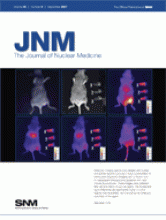TO THE EDITOR: We read with great interest the paper from Ong et al. (1) in the April issue. This study was the first to investigate the potential impact of calcitonin serum blood level and doubling time on 18F-FDG PET performance in the restaging of medullary thyroid carcinoma. On the basis of previously published papers dealing, first, with the influence of CA15-3 blood level and doubling time on PET performance in breast cancer patients with occult recurrence (2) and, second, with tumor markers in medullary thyroid carcinoma (3,4), several remarks may be addressed concerning the study of Ong et al.
Calcitonin doubling time could be calculated in 22 of the 38 PET scans in the series, and no significant difference was found in calcitonin doubling time between true-positive and false-negative PET findings.
Because the choice of a 1,000 ng/mL cutoff for calcitonin improved PET sensitivity from 62% to 78%, it would be interesting to investigate whether the likelihood of depicting recurrence is higher in patients with both a calcitonin blood level above 1,000 ng/mL (this value not being applicable in other institutions, as stated by the authors) and a short doubling time. It has been demonstrated in breast cancer that the combination of tumor marker blood level and doubling time may be useful in improving PET accuracy if patient selection is based on both criteria (2). The proportion of positive PET findings among patients with a low calcitonin blood level but short doubling time could also have been detailed, despite the fact that the sample was probably too small for definite conclusions to be drawn. For these purposes, a doubling-time cutoff of 6 mo could be applied, because this cutoff value has been proven to be a reliable prognostic factor in medullary thyroid carcinoma (3,4).
Footnotes
-
COPYRIGHT © 2007 by the Society of Nuclear Medicine, Inc.







